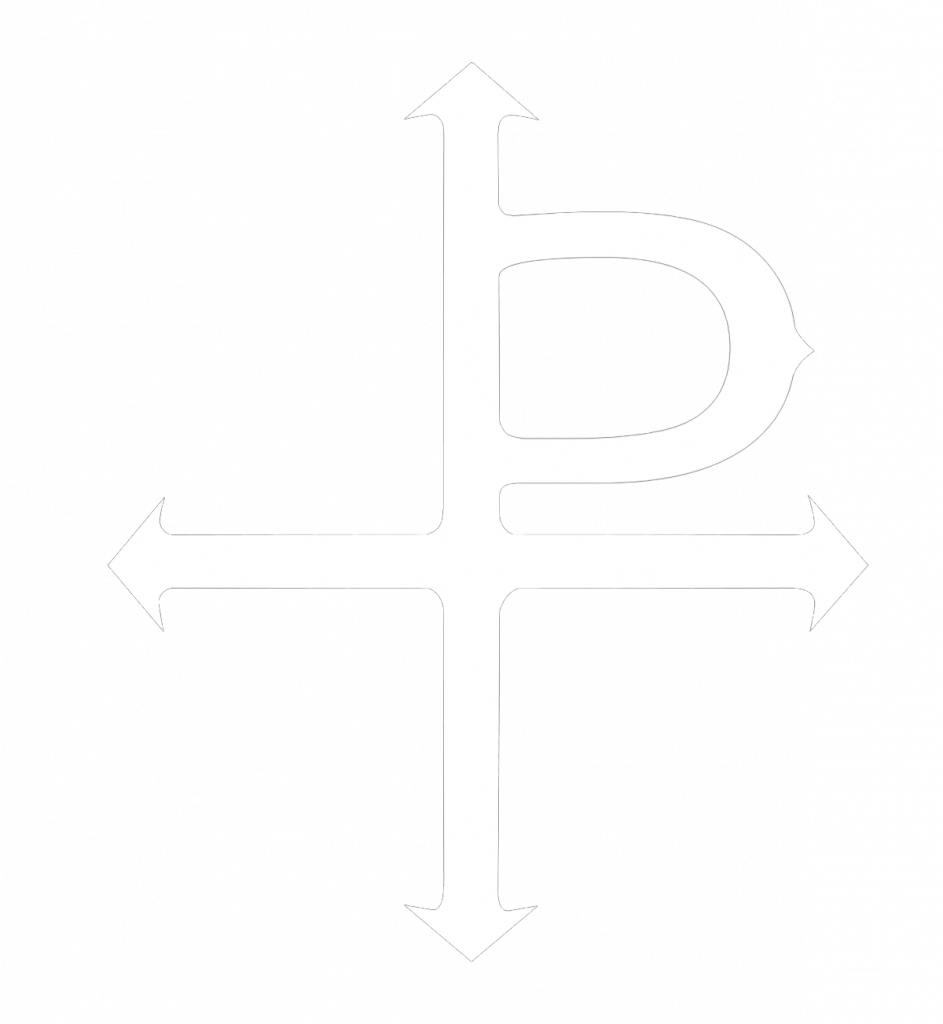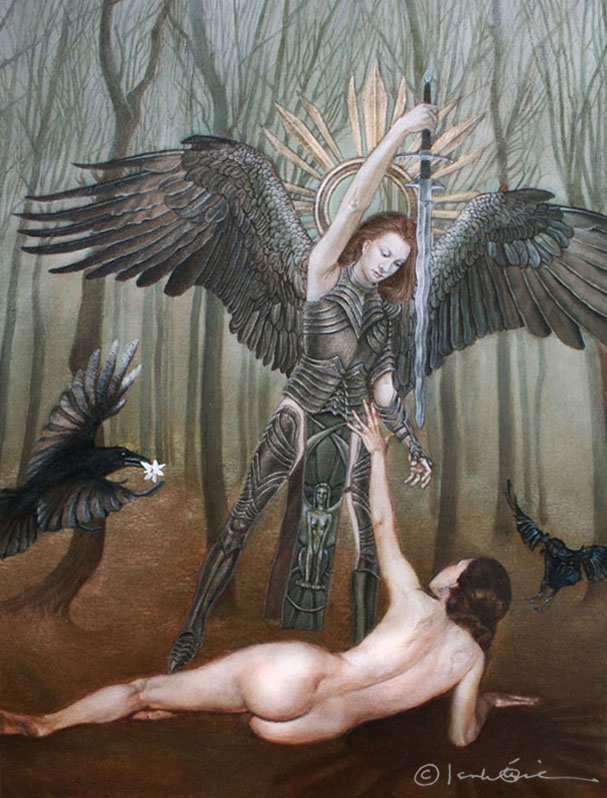
Oil on canvas
18 x 24’’
2010
Please click on the images for a larger view.
This painting started out as a commissioned piece for a local metal magazine cover, with the ad nauseam theme “Women in Metal”. In spite of my virtually misogynistic views on the subject, I approached the whole project tongue-in-cheek, and used it as a platform for social critique on why the XX chromosomes’ take on my favorite musical genre generally doesn’t cut it in spite of the rarae aves.
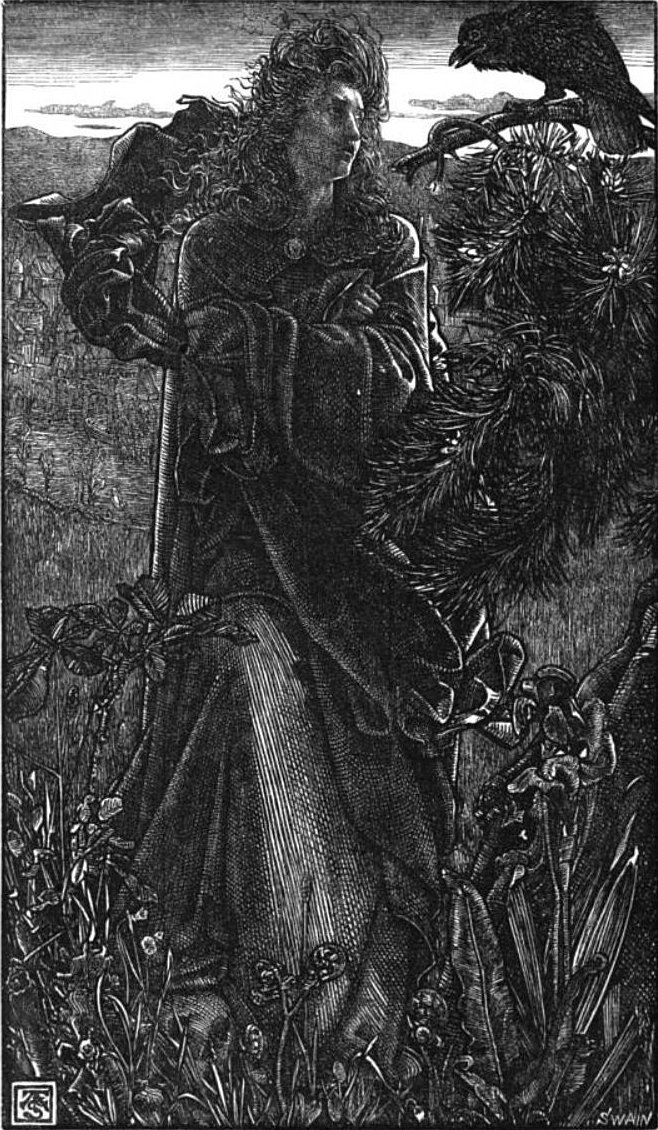
Speaking of birds, the illustration “A Valkyrie Speaks With a Raven” by Anthony Frederick Augustus Sandys (fig. 1) jump started the entire concept. I was drawn to the artist’s rendition of a ‘shield maiden’ being so androgenous, even masculine – And this was supposed to be a Romanticized and sensual symbol of macho death at that. With the arbeit macht frei approach, one reference lead to another until the idea was complete.
The more I read about valkyries, all these connections with the altruistic St. Michael the Archangel, who is also somewhat a warrior-Charon of souls came to light. However, St. Michael is an upgraded version, with his name literally translating to “who is like god”. But, despite having healing powers and ability to pass judgment he is still unlike the valkyrie, in not being able to choose who is going to die.
The armored, sword-wielding figure in the painting is a combination of these two mythological figures to express an opinionated view on the female gender. Her stance alludes to this famous statue of St. Michael by August Vogel (fig. 2), the ravens connect her with the valkyrie, whilst the armor and wings are characteristics of both. She personifies an ideal woman. One who strives for having no distinction from the opposite gender in terms of ability, and one who does not capitalize on sexuality for attention and power –just as I amalgamated the best traits of both.
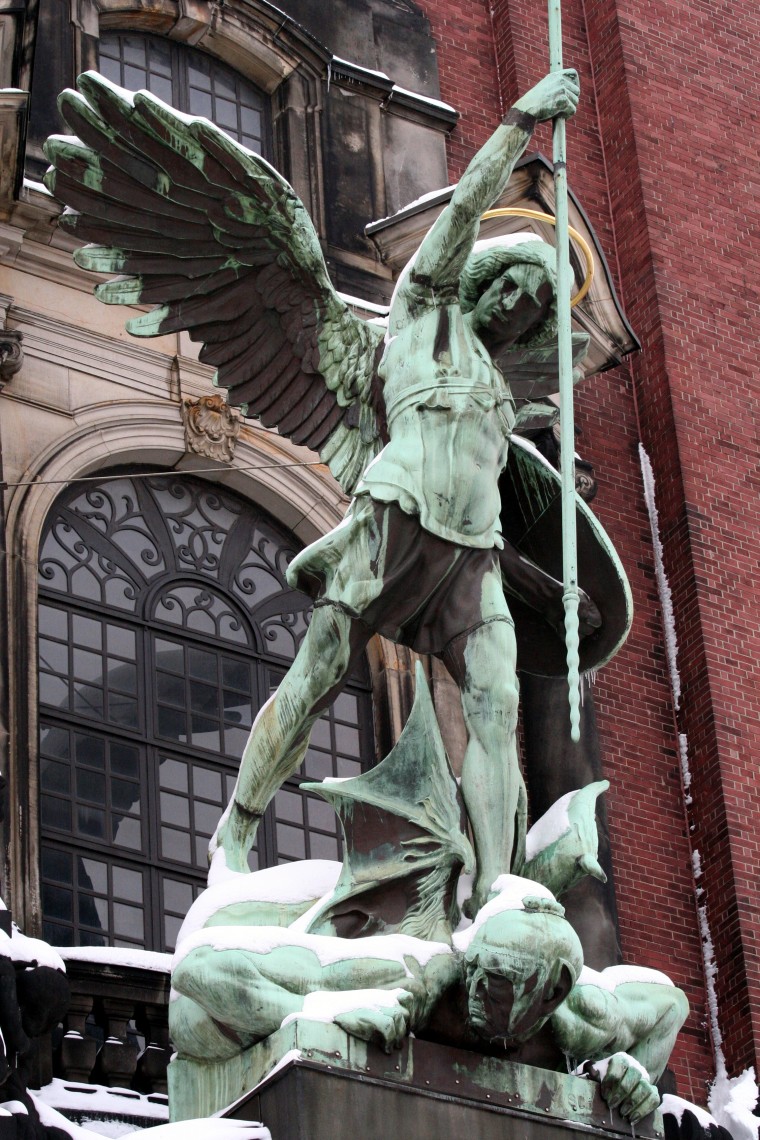
The nude reclining figure was intended to be a parody of the Rokeby Venus by Diego Velasquez (fig. 3), the leading Spanish artist of the Golden age. On a literal level, Velasquez’s painting personifies what I condemn about my gender – Using transient beauty, helplessness and eroticism as manipulative devices, or to put it more bluntly, as an excuse to disregard other means of personal development with an ‘end justifies the means’ mind-set. This initial impression was affirmed by the painting’s vandalism (fig. 4) in 1914 by Mary Richardson of the British Suffragette Movement, who hacked it with a butcher knife for the same reasons.

On the other hand, upon further examination (and referring with some ‘professional’ critiques), it turns out that the Rokeby Venus may well be a parody in itself. The reflection of her face on the mirror is deliberately inaccurate, being inconsistent with her body’s position. Her face is also oddly blurred, emphasizing this ‘pictorial departure’. There have also been remarks about Cupid’s face being forlorn, though dejected might be a more appropriate term, and a lot of speculation on the symbolic significance of the silk ribbons/fetters on the mirror. My take would be that these fetters, otherwise used by Cupid to bind lovers, were calculatingly left unraveled to emphasize how real love is detached from this self-absorbed beauty.
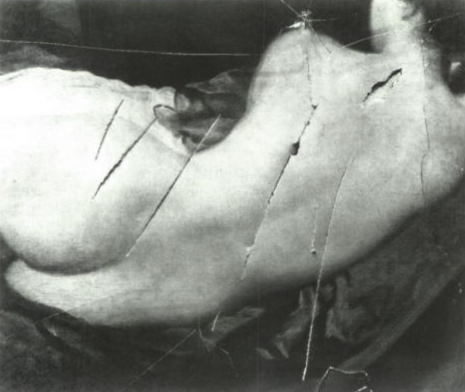
Naturally, I underwent a compositional crisis. Being the least inclined person to advocate contemporary feminism, I unfortunately perceived the painting the same way they did, and it felt like I had slapped myself, HARD. There’s a quotation by Socrates that goes “From the deepest desires often come the deadliest hate.”, and inadvertently the painting embraced this whole new meaning. Did it suddenly represent how I’ve repressed all my womanly characteristics when I’ve been left with no other choice by being born female? Was a little empathy and forgiveness towards myself and gender in order? Is the real issue ‘self-absorbed beauty’ which is individual based and rather gender indifferent? Perhaps, –Though my stand regarding women in metal remains unperturbed.
* * *
Instead of explaining all the imagery, I would like to include my notes, so that the viewer may devise the other hidden meanings of this artwork.
The Raven is a symbol of prophecy, thought and secrets. Its cackle sounds like ‘CRAS’ which is the Latin word for tomorrow. Though they represent the dark side of the psyche in Jungian Psychology, other cultures such as the North American Indian, Greek, and Roman associate them with light, or metaphorically the ‘light of wisdom’. The Norse God Odin was always accompanied by two ravens: Hugin and Mugin, who he sent throughout the land to spy on events. Being talkative creatures, they were said to have been white, until Apollo turned them black as punishment for not being able to keep a secret. This parallels with the Biblical story of Noah where bird he initially sent out to find land was a white raven. God had turned them black for this individual’s failure to complete the task.
The Greek Sphinx has the body of a lion, the head and breasts of a woman and the wings of a large bird. “Treacherous and merciless” , She kills and devours those who cannot answer her riddle: Which creature in the morning goes on four legs, at mid-day on two, and in the evening upon three, and the more legs it has, the weaker it be?
The Tuberose is a night blooming flower that grows best in warm climates. It is prized for its sensual scent and is used in India for both weddings and funerals. It has medicinal qualities that promote relaxation, treats emotional blocks, impotence and frigidity. In France, young women were advised to avoid the tuberose’s scent in the evening, lest it incites amorous feelings and frivolous behavior. In Victorian England, they were regarded as ominous because they were common in gravesites. Their fragrance was once thought to be able to kill a person under prolonged exposure. They also symbolize dangerous and forbidden pleasures.
* * *
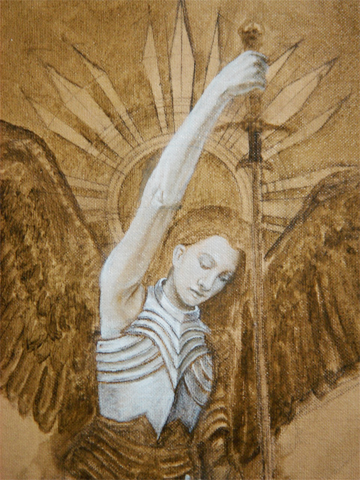
This painting has Mannerist elements and was created using the techniques of Flemish painter Peter Paul Reubens with a diluted warm grey imprimatura and underpainting in burnt umber. Certain elements utilize iridescent pigments which are not brought to justice by a digital photograph.
